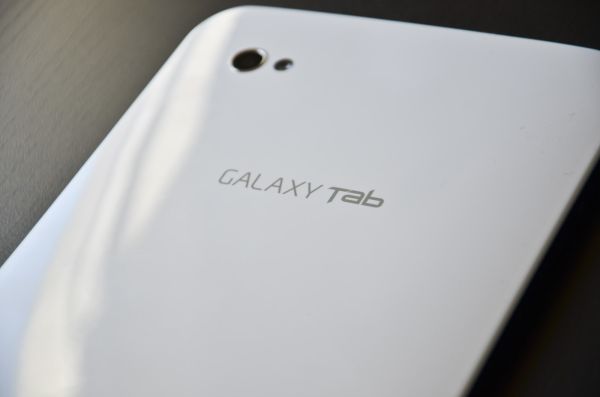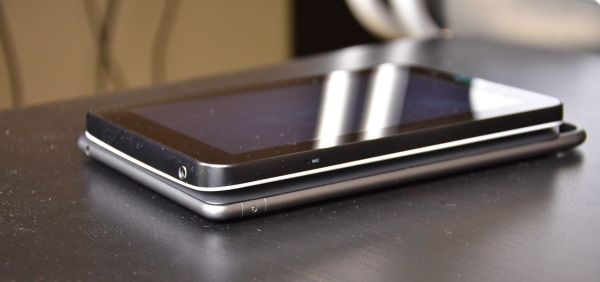Battle of the Budget Tablets - Nook Color vs. Galaxy Tab
by Vivek Gowri on May 25, 2011 12:52 AM ESTMeet the Contenders - Galaxy Tab WiFi
The Galaxy Tab WiFi is very similar to the Galaxy Tab we reviewed previously, and that’s a good thing. Even if I thought the software was too smartphone-like to be very useful, I liked the Galaxy Tab hardware, and that has stayed mostly the same here. The design hasn’t changed, with a very minimalistic front face and thin bezels the entire way around. Even with the same size screen, the Galaxy Tab ends up being significantly more compact than the Nook. The sides are still matte black, but our WiFi review sample has a glossy white back instead of the Darth Vader all-black look our Verizon 3G review unit had. It’s a good look, though I’d have preferred an all-white device rather than a two tone aesthetic.
Most of the differences lie internally. Beyond the obvious lack of any 3G radios, we see that Samsung's venerable Hummingbird SoC has been swapped out for TI's OMAP 3630, featuring the same 1GHz Cortex A8 and and a PowerVR SGX 530 GPU. The SGX 530 is roughly half as powerful as the SGX 540 pixel pusher in Hummingbird, so it's a relatively significant downgrade. Speaking of downgrades, the Bluetooth 3.0 radio has been dropped in favor of Bluetooth 2.1, though that is pretty minor compared to the SoC switch. Other than that, there's the same 16GB built-in flash storage (plus microSD expansion), the same front facing 1.3MP and rear facing 3MP cameras, the same beautiful 7” WSVGA display, and the same TouchWiz skin on top of Froyo. The Gingerbread update is scheduled to release to devices within the next few weeks.
Great, so why are we here? Because, well, the WiFi-edition Galaxy Tab is downright cheap - at $350 it’s going after the crowd that thought the iPad was too expensive, thought the Xoom was ludicrously expensive, and would otherwise end up with something like the Viewsonic G Slate. Trust this guy, the Samsung is better. Way better. But how does it stack up against the even less expensive Nook Color?


















89 Comments
View All Comments
Johnmcl7 - Wednesday, May 25, 2011 - link
I'd assumed the two Tabs were identical bar the 3G, I found out about the downgraded Wifi version recently thankfully after I'd bought the 3G version as I'd been annoyed to have bought the wifi version and then found out about the inferior spec.I think you're quite right to say here the SoC downgrade is pretty terrible but I'd say the article doesn't make that very clear on the first page and the Tab intro.
John
VivekGowri - Wednesday, May 25, 2011 - link
To be completely fair, it's not the biggest deal in the world - unless you're gaming a lot, you won't notice. And when I say gaming, I mean serious 3D games; Angry Birds and other casual games run just fine on OMAP 3.It just bugs me that Samsung was really, really not forthcoming about the SoC change at all.
Oscarcharliezulu - Wednesday, May 25, 2011 - link
As a consultant, the cameras are extremely useful to take pictures of (non electronic) whiteboards, a presenter's ppt at a conference (where you might not be able to get a copy easily or quickly) and then add your notes to it. Lots of my colleagues do this also.I also use it to take pictures for eBay listings.
Im always surprised when a journalist states they can't imagine what the camera is for just because they don't use it. Hope this helps your research.
VivekGowri - Wednesday, May 25, 2011 - link
Okay, this is exactly what I want - I don't use it, so I want to know what people do use it for. Thanks for your response!See, I do take a lot of pictures of documents, notes, homework sheets, etc, but even though I usually have a tablet with me (usually either my iPad or whichever one I'm testing), I mostly end up taking those pictures with whatever smartphone I'm carrying. It just feels much more natural to take pictures with a smartphone, either because the similar size of the phone and a point and shoot, or because we're just conditioned to cameraphones.
Like, I guess my question is more - when everyone has a smartphone/cameraphone, do tablets (which generally have the same or sometimes worse sensors than their smartphone cousins, and are more awkward to take pictures with) really get used as cameras that often?
mushu - Wednesday, May 25, 2011 - link
Thanks for the writeup Vivek. Good to see a comparison here on anandtech. A few of points:- the OC kernel for the nook supports speeds up to 1.2 GHz and the previous kernel went up to 1.3.
- Many people feel there're significant differences wrt performance and usability between the latest linux (2.6.32-based) kernel and the one preceding it (.29).
- If you use the 2.6.32 kernel make sure you also use the latest B&N bootloader, otherwise you'll encounter several performance related problems, notably with video.
- Make sure you have good battery data and that you don't only look at one kind of task. When mucking about with custom ROMs and kernels and bootloaders you run the risk of suffering from errors related to battery calibration. I regularly get 8-10 hours of surfing and reading on my NC, ie. with screen and wifi on and never at peace.
- I hope you looked at the cyanogenmod settings dialog where there is a set of tablet tweaks! Most important of these is the ability to have the softkeys and the status bar at the bottom of the screen. About as limited as honeycomb tablets may get without standard hardware keys :P Ie. not very limited at all. Move the keys down Vivek :o
- Never mind the stock browser on any non-honeycomb android device. Check out opera mobile.
The nook is a great device for those who enjoy tinkering and who do not want to pay extra for things like cameras.
VivekGowri - Wednesday, May 25, 2011 - link
Haha, right now I wish I had talked to you before I started this article. You know a lot more about this than I do, all of which I picked up in a brief amount of surfing on the XDA forums. I went for a quick root - just the latest rev of CM7 (about three weeks ago?), Google Apps, and that's it. I'm not a huge proponent of overclocking mobile devices, since the long-term wear and tear it results in tends to shorten the life of the system.I like the bar being at the top, and I didn't mind the softkeys being up there, it just required a little bit of mental recalibration. I'll check that out though!
Battery-wise, that's about what I was expecting - B&N quotes 8 hours of life with the wifi off, so 6.5 hours with a stressful wifi test sounded fine to me. I understand that people can do a ton of tinkering and tweaking to the OS for performance, battery, usability, whatever floats their boat, and I really love that about the Nook Color. I just wanted to get a feel for what it was at the base level.
MonkeyPaw - Wednesday, May 25, 2011 - link
Yeah CM7 is constantly improving with nightly builds, so 3 weeks ago is actually a long time. There are other options that update, too. I ran rooted 1.2 until the beta 3.1 with sleep fix. I've been running the beta for a week and had great luck. Took maybe 15 minutes to get it running. The NC really is a great piece of hardware for the price. If you like playing with new ROMs as much as you like using it as a tablet, its a fun purchase. There's even an Ubuntu build under development.VivekGowri - Thursday, May 26, 2011 - link
I had the Nook for exactly 2 weeks, I didn't want to spend a whole bunch of time experimenting with various ROMs and nightly builds. I just grabbed the latest nightly and went from there. But that's basically what I was referring to - if you want to get really into that, there's a great community behind development for the Nook.Shadowmaster625 - Wednesday, May 25, 2011 - link
Can we get battery life and surface temperature readings of an 800 MHz Nook vs a 1000 MHz Nook?RomanMtz - Wednesday, May 25, 2011 - link
How does the Viewsonic G-Tablet compare to these at $289?